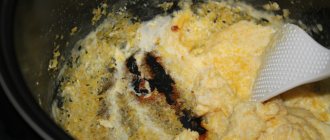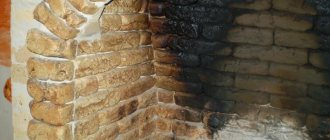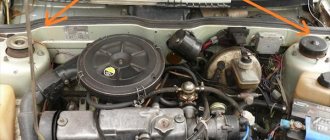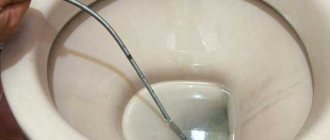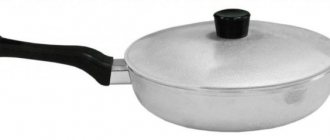I like cast iron frying pans for their practicality and long service life. But even with them, sometimes “embarrassments” happen and the food being prepared begins to burn. I long ago learned how to treat cast iron frying pans in such a way as to prevent their damage. Now I want to share my experience with you.
To prevent the dishes from burning, they must be heated periodically
Why does a cast iron frying pan smear black?
Reasons for the appearance of black spots on dishes.
- Defective goods. The surface of the pan may have been damaged during production. It is difficult to detect microcracks on it with the naked eye.
- Remains of fat base. During the manufacture of products, machine oil is used. In some cases it remains on the surface of the product.
- Incorrect care. Soda-based detergents are not always suitable for daily care of a cast iron frying pan.
It is important to remember that if you constantly take care of a cast iron frying pan, it will last for several generations, and you can fry whatever you want on it.
Attention! Black deposits on kitchen utensils can completely ruin the taste of a dish. It can be removed by calcination and other methods.
Read also: You need to value time. Writer24
Care instructions
The main answer to the question of why a cast iron frying pan burns is considered to be improper care of it. To prevent damage to the product, you must follow simple rules.
After cleaning, always dry the dishes and store them in a dry place.
- Do not wait until a thick layer of soot forms on the pan . It has a bad effect on its operation.
- Clean the product regularly . Wipe the pan dry each time after cleaning.
- Store utensils correctly . Cast iron products are best stored in a dark, dry place where the risk of corrosion is minimal.
Why does food burn in a cast iron frying pan and what to do about it
This product is durable, but it has a significant drawback. Burning in such a frying pan will surprise few people. After repeated frying, food begins to stick to the bottom of the cast iron cookware as soon as it warms up.
When everything sticks to the bottom of a cast-iron frying pan, experienced housewives will tell you what to do.
This kind of trouble can arise for the following reasons:
- Incorrect operation. Food can burn even on a new cast iron frying pan if it was processed without taking into account the recommendations of specialists.
- Care not according to instructions. Any coating will fail prematurely if the utensils are used and stored incorrectly.
- Buying a fake. If you want to save on kitchen utensils, the chance of getting low-quality products increases. Defective goods will also affect the long-term use of the product.
There are several simple recipes for restoring the natural non-stick coating.
Important! If a problem arises, you should not send your cast iron frying pan to the scrap yard. It can be restored using simple steps with salt, oil, soda and other means.
What can you cook in a cast iron frying pan?
Dishes made from this material are highly durable. Its shelf life, if used correctly, can be measured in decades. Cast iron weighs a lot, but will ultimately last a long time.
Strong, durable, it sometimes presents unpleasant surprises.
You can cook any dish in such a frying pan. When heated well, pancakes and pancakes are perfectly baked on it. Meat food is also easily prepared using a cast iron frying pan. You can fry vegetables, mushrooms and roast seeds on it.
How to clean blackness from a frying pan
If you have an existing problem, you can try two ways to get rid of carbon deposits.
Lemon acid
There are two recipes for using this substance.
- Soap + citric acid. 4 tsp The caustic substance must be diluted in 2 liters of water. The resulting mixture should be boiled and kept on low heat for half an hour. Then the dishes are washed with a solution of laundry soap at the rate of half a piece of soap per liter of water. You can use any citric acid remover. However, for greater effect, you should use laundry soap.
- Vinegar + citric acid. The walls of the frying pan are treated with the resulting mixture while wearing gloves. It is prepared from 2 liters of water, 100 g of citric acid and 150 ml of vinegar. The liquid should be boiled, immerse the frying pan in it for half an hour, and then rinse the dishes under running water.
The burnt vessel is poured with an acidic solution.
Mustard powder
You can treat the walls of the frying pan with this caustic substance. They can really clean the inside and outside of it without damaging the coating of the product.
Mustard is an excellent remedy for fat and soot.
Recipe for carbon remover:
- Making pasta. Make it from 1 tsp. mustard powder and 100 ml of water.
- Surface treatment. Using a soft brush, you need to lubricate the problem areas of the dishes with blackening. The paste should be thoroughly rubbed into the surface of the pan.
If there is old carbon deposits, this recipe will not help. You need to add a little vinegar to the paste. Use the resulting mixture to treat black spots and do not wash it off for 5-6 hours. After this time, the dishes should be wiped with a soft sponge.
The hot processing method is boiling with mustard solution.
Soda and vinegar solution
This composition is used if food begins to burn due to rust. You can avoid the problem as follows:
- Selection of container. Its dimensions depend on the degree of damage to the walls of the cast iron frying pan. If most of it is damaged, then you will need a saucepan of impressive size.
- Treatment with soda and vinegar. In solution per 1 tsp. For each ingredient per liter of water, the dishes need to be soaked for three hours. If you shorten the processing time, vinegar and soda will not be able to dissolve the rust.
When sodium bicarbonate is quenched, oxygen is formed. It breaks down old dirt well.
Important! If you want to leave the product in the solution for four hours, there is a risk of destruction of the cast iron base of the cookware.
Cleaning with glue and soap
Carbon deposits can be removed using a simple recipe.
- Preparation of the composition. Its base is 0.5 kg of soda, 300 ml of office glue and crushed laundry soap. Mix the ingredients and add 1 liter of water.
- Warming up. The frying pan is placed in a large container and placed in the oven. The processing time of the dishes depends on the speed of separation of soot from its walls.
- Washing. It is produced in hot water using a brush with a soft base.
Pots, pans, cutlery, and bowls were cleaned by boiling in a solution of laundry soap and silicate glue.
Advantages of cast iron
The biggest benefit of cast iron cookware is its versatility. Non-stick frying pans smoke nervously on the sidelines when a time-tested cast iron appears on the stove, in which you can perfectly fry steak, fish or scrambled eggs. Uneven heating, which everyone who cooked on a gas stove has encountered in one way or another, is not scary with a cast iron frying pan. That's because the thick walls of cast iron distribute heat evenly, enveloping your food in a gentle heat that will make even the toughest meat release its juices.
Another way to prevent burning
To reduce the risk of food sticking and burning not only in cast iron, but in any cookware, use a fire spreader. Often carbon deposits occur where the gas burner flame was most intense. Evenly distributed heat heats food equally throughout the entire bottom of the container.
When a new cast iron skillet burns, it means you haven't prepared it for use. The newness of the metal is absolutely no guarantee that the utensils will not begin to act up. Be sure to heat the dishes in any convenient way.
How to care for your frying pan
Cast iron is a material that is resistant to any deformation, and with proper care you can fry on it for many years. Its operation can be extended if certain rules are followed.
- Calcination. It is produced by heating it in the oven at a temperature of up to 180 C. In this case, it is better to use oil to create a non-stick layer.
- The washing up. A new frying pan should not be processed in cold water. Boiling water is also not suitable for preparing dishes for use. It is necessary to wash kitchen utensils in hot water with a soap base added to it. The brush for this treatment should not contain metal elements. It is better to opt for a soft sponge.
Before storing the frying pan, it is treated with an oiled cloth.
In this form, the pan will not become rusty in high humidity. Caring for cast iron cookware is not limited to primary processing. After using it, it is recommended to adhere to the following tips.
If food still begins to burn on cast iron utensils, it is easy to return the pan to its former versatility.
- Timely cleaning. A crust that forms on the surface of the pan is a signal that the pan is not being properly cared for. You should clean the utensils with a soft sponge and hot water after each cooking.
- Limit the use of soap. Water with a reasonable dosage will clean the surface of a cast iron frying pan. Bleach is not allowed when processing the contaminated part of such dishes.
- Regular drying. Food can burn and stick to the sides of a cast iron skillet if there is rust on the bottom. This problem can be avoided by drying the dishes after each use.
- Avoiding the dishwasher. The time saved will ultimately lead to breakdown of expensive equipment and damage to the surface of the cast iron frying pan.
- Using a wooden spatula. Some housewives believe that cast iron is not afraid of scratches. Such a misconception leads to the fact that their food then burns on a surface damaged by sharp objects.
- Storage on a stand. It is better to keep the frying pan separate from the rest of the dishes. A stand made of wood or stainless steel is suitable.
- Frequent use. Cast iron is a material that needs to be regularly treated with a fat base. In this case, it will last longer and rust will not form on it.
Products are placed only on a heated surface.
Attention! In case of significant contamination, you can resort to a radical method of cleaning the dishes. To do this, it is heated in the oven to 260 C. Residues of food eventually turn into ash and are easily removed with a napkin.
What should you do if your frying pan burns from time to time? The main thing is not to rush if you want to purchase a new product. A cast iron product will last for many years if you care for it properly.
Do not forget that in order for the dishes to serve reliably, they need to be properly cared for.
Why does the burn appear?
Burning appears only on those pans that are made of porous materials: cast iron, aluminum. Enamel also has this structure. To avoid problems with the dishes, they should be treated before cooking. It is convenient to use non-stick pans. They do not require any preparation, and some frying can be done without adding oil. If a frying pan is burnt, what should you do? The processing method depends on the type of surface.
The importance and stages of preliminary preparation
Preparing cast iron cookware for the first use for its intended purpose includes three main steps :
- cleaning from transportation coating;
- calcination;
- sealing pores.
All three steps are important and must be completed sequentially.
Cast iron is a durable but vulnerable material. Its main enemy is moisture. To protect new pots, cauldrons and frying pans, manufacturers cover the outer and inner surfaces of the products with a thin film of mineral oils or other sealant.
The oil film protects the metal from moisture generated by temperature changes and oxidation. And even if the composition is safe for health, it will negatively affect the taste and aroma of dishes. The first task is to wash off the technical lubricant without damaging the surface.
The second stage, calcination, removes residual technical lubricant from the pores. This is very important, since during washing only the surface is cleaned, and cast iron is a porous material. If you skip calcination, residual mineral lubricants will get into your food.
The third step is clogging the pores. Cast iron has natural non-stick properties. They are due to the fact that the pores become clogged with fats over time, making the surface smooth. In order not to wait for this to happen, you need to lubricate the bottom and sides with oil using rubbing movements and do not wet it after that.
If an aluminum pan burns (without any coating)
Aluminum is close in structure to a cast iron alloy. When the oxide layer wears unevenly or is destroyed by detergents, food begins to burn - it fills the recesses of the uneven bottom. If an aluminum frying pan burns, what should you do?
To restore the oxide film, the duralumin alloy is calcined:
- Pour a little vegetable oil onto a clean dish (1-2 mm layer);
- Pour coarse salt - no more than 3 tbsp. spoons, level it;
- Place the frying pan over low heat to heat evenly;
- When the oil begins to smoke and evaporate, the dishes are transferred to a cooling rack.
By the way, this procedure is carried out regularly as soon as burning occurs - then the duralumin cookware will last a long time.
The shelf life of Teflon quickly decreases if not properly maintained.
Heating a frying pan: 3 ways
When the pores on a cast iron surface become clogged, it begins to rust, food takes on a burnt appearance and an unpleasant odor. If a cast iron frying pan burns, experienced housewives know what to do: cast iron needs to be calcined. There are three ways to do this, each with its own advantages.
Method 1. Conventional calcination
A cast iron vessel must be treated with detergent, rinsed, and dried. After this, an oil layer is applied. It is better to coat the frying pan with a silicone brush so that the micropores are well filled. For firing, the dishes are placed in a hot oven. At temperatures up to 180 degrees, it must be kept in the closet for up to 30 minutes. Once the old frying pan has cooled, you can use it again.
Heating a cast iron frying pan with salt.
Method 2. Calcination with salt
Treatment is carried out at the first signs of burning. For the procedure, coarse salt is used; it is more convenient to work with. A clean vessel is placed on the fire to evaporate the moisture. Sprinkle salt onto a dry, hot surface in a thick layer and heat it up, stirring occasionally. The appearance of an odor indicates that adhered food particles are burning out. After the salt turns yellow, the procedure is completed. The vessel is rinsed and wiped dry.
Method 3. Calcination with oil
The surface is perfectly restored by oil firing. The cast iron is preheated. Pour the oil into a layer of at least 5 mm and leave on the fire for up to 30 minutes. If there is a lot of smoke, the fire can be extinguished earlier. Wipe the pan dry with a cloth or paper towels.
Heating a cast iron frying pan with oil.
Cleaning
If a ceramic frying pan is burnt, what should you do? If the dishes are still damaged, you need to do the following:
- The pan needs to be washed.
- Then it is dried.
- The surface should be rubbed with vegetable oil.
- The impregnation should be left for several days.
- Then you need to wash off the remaining oil with warm soapy water.
This completes the procedure for cleaning the ceramic surface. Proper care of your cookware will extend its service life.
Cleaning the frying pan
There are times when a cast iron frying pan gets burnt. How can I clean it now and return it to its original appearance?
In order to clean a burnt frying pan at home, you can use your grandmother’s old methods. Most household cleaning products will work for this procedure.
Lemon acid
This product has a wide range of uses. It is absolutely safe and incredibly effective in cleaning procedures. To clean a cast iron frying pan you need:
- Wash the pan.
- Sprinkle citric acid over its entire surface.
- Wait until the acid is absorbed into the pores of the surface of the cast iron pan. This is approximately 3-5 minutes.
- Wash the pan as usual.
Mustard powder
The most stubborn fat can be removed with mustard powder. You need to do this:
- Pre-melt the fat that has accumulated on the inner surface of the pan.
- Drain it and rub the surface of the frying pan with mustard powder.
- After half an hour, rinse with running water.
Soda and table vinegar
- Mix baking soda and vinegar in equal proportions.
- Due to a chemical reaction, a paste is formed.
- Rub the surface of the pan with it and wait 30 minutes.
- The paste will eat away all the carbon deposits. Use the hard side of the sponge to remove it.
Soap and glue
This is the most common and effective recipe that our grandmothers used. It works like this:
- You will need laundry soap. To quickly dissolve it in water, grate it on a coarse grater. You will need one block.
- You need to find a container suitable for washing the frying pan.
- Pour water into it and boil.
- Add a small tube of PVA glue and soap shavings.
- Mix thoroughly.
- We lower our vessel into the resulting mixture and boil for about 2-3 hours.
- After cooling, wash the pan as usual.
Sometimes it happens that even with proper storage and care of a cast iron frying pan, troubles occur when frying pancakes. They don't want to come off, they burn. Therefore, never use a new frying pan to cook pancakes. The necessary procedures with it after purchase do not 100% guarantee that the baked goods will turn out “perfectly”. Only an old frying pan can cope with this task.
Seasoning a cast iron frying pan
There are several ways to season a cast iron frying pan. By using one of them, you will be able to use it for its intended purpose for a long time without any problems.
Method 1
Quite a simple way:
- The oven must be preheated to 220 degrees.
- We put a frying pan here.
- Continuous heat treatment must last for at least 3 hours.
- After turning off, the pan should cool down inside the oven.
If the handle on the frying pan is not removable, this method will not work.
Method 2
By applying high temperatures, you can create a non-stick coating on the surface of a cast iron pan. For this you will need vegetable oil. This procedure can be carried out on the stove or in the oven:
- The pan must be rinsed and dried.
- Pour 1 centimeter of salt into the bowl.
- Heat in the oven or on the stove for at least 1 hour.
- Pour in salt and grease with vegetable oil.
The non-stick coating on a cast iron skillet improves the more often it is used.
Method 3
There is another time-tested method. This procedure is effective, but labor-intensive. You must proceed as follows:
- Preheat the oven to 220 degrees.
- Place the pan in the oven and wait until it reaches the same temperature.
- We carefully take it out.
- Wet the entire surface of the frying pan with vegetable oil.
- Place it back into the oven.
- After the oil burns out, turn off the oven.
- After cooling completely, take out the frying pan.
What to do with a Teflon frying pan to prevent food from burning
This coating requires delicate care. What to do if a Teflon frying pan burns? In this case, vegetable oil will help. Teflon will last less than steel. However, its service life will increase after regular greasing of the bottom and walls of the frying pan.
The shelf life of Teflon quickly decreases if not properly maintained.
The thirtieth wash is a signal for the need to replenish the Teflon coating with vegetable oil. It should be heated, cooled and gently rubbed into the walls of an aluminum frying pan.
It should be taken into account that refurbished Teflon will not last long and the dishes will have to be replaced.
How to care for cast iron cookware so it doesn't burn
Cast iron is a very durable metal and is resistant to abrasive household environments and metal brushes. You can clean frying pans and cauldrons made of this metal using any means convenient for you (gels, cleansers, anti-grease liquids).
But to prevent the dishes from starting to burn again, be sure to wipe them with a napkin after washing and lubricate them with a piece of fat (a thin layer) or at least vegetable oil (dip a napkin in the oil and wipe the bottom with it). Let the frying pan be stored with this treatment.
Place it in a protected, closed place, otherwise dust will settle on the oil surface.
Some people are wondering, does food burn in a cast iron frying pan if you fry it without oil? Yes! Cast iron is not suitable for cooking food on it without the use of any oils or fats. For this purpose, purchase cookware with a special non-stick coating.
Basic Rules
Even if calcining a vessel does not seem like a complicated procedure to you, you should still carefully study and adhere to the simplest but most important rules.
- Oil is a highly flammable substance! Be careful when heating it.
- Salt for calcination, it is advisable to use medium or coarse grinding. Salt must be without any additional substances.
- Used oil and salt should only be disposed of when the substances have cooled completely. Firstly, the effect of such a procedure is enhanced, and secondly, it is much safer.
What to do if the pan starts to burn?
It often happens that a favorite frying pan, in which more than one dish has been cooked, suddenly begins to spoil the food. To prevent food from sticking, there are several ways to restore kitchen utensils to their former properties and prevent further food burning. All restoration methods do not require the use of hard-to-find materials and can be easily applied at home.
Why did the pan start to burn?
Food can stick to any surface, regardless of whether it has an additional protective coating or not. For non-stick kitchen utensils, the cause of food sticking may be a poor-quality product (manufacturing defect) or surface wear. Teflon, titanium, marble, and other types of cookware have an expiration date. Before you understand what you need to do to prevent the pan from sticking, you should understand what factors contribute to food sticking.
The main reason why food starts to burn is the porous surface of the kitchen product. Aluminum, cast iron and enamel cookware have this structure.
Removing food debris
If a new frying pan, which has been in use only a few times, suddenly begins to burn, the cause may be improper care of its surface. Many housewives use harsh chemicals or harsh abrasives to remove food debris. They negatively affect the technical condition of kitchen utensils. But, if you don’t completely clean the walls and bottom of food particles and start preparing the next dish, the food can also burn.
What can I do to prevent the pan from burning?
If food sticks to the pan, do not immediately throw away the pan. There are several ways to get rid of this problem and prevent it from occurring in the future.
Cast iron frying pan burns
To prevent food from sticking to the surface of the cookware, which was made from an alloy of iron and carbon, it is necessary to restore its natural non-stick layer. To do this, you will need to clean the surface of the kitchen product with detergent and then dry it. A natural or forced drying process is allowed, i.e., place the dishes on the stove and wait until the moisture has completely evaporated. You can't overheat.
When the dishes are completely dry, cover the bottom with a layer of salt (1-2 cm) and place on the fire. It is necessary to heat the metal for about 5 minutes. When the salt begins to crackle and change color, remove the cast iron product from the heat. You should not keep the dishes on the stove for a long time. When the pan has cooled down on its own, you can remove the salt, wipe the bottom with a paper towel (soft cloth) and wipe the surface with refined oil.
If you know how to properly heat and store a frying pan, you can restore even the oldest utensils. Cast iron products do not like high humidity. They also require constant care. The calcination procedure is recommended to be done after 30-35 times of using the kitchen appliance.
Uncoated aluminum frying pan burns
Microparticles of food penetrate into the porous structure of aluminum if the dishes are without an additional protective coating, and therefore the food begins to burn. It is recommended to restore such a surface using vegetable oil. Pour it so that it covers the entire bottom and add 2 tbsp. salt. The dishes are placed on the stove and the heat is turned on low. When a slight smoke begins to appear on the surface, remove the pan from the stove. After cooling, the contents are removed and rinsed with water. Detergent must not be used.
When a frying pan burns, a thorough inspection of its surface can tell you what to do. If there are deep scratches on the walls, you can try frying bread in it. Cut pieces of baked goods are laid out on a dry bottom (without adding oil or fat) and kept on fire until completely dry. When a golden brown crust begins to form on the bread, remove the pan from the stove and wait until it cools completely, and then wipe it with a paper towel. Additionally, you can grease the bottom.
Ceramic frying pan burns
Ceramic dishes can be restored with oil. It is cleaned of burnt food with detergent, wiped with a soft towel (you can dry it on the stove), and then treat the surface with oil or a piece of lard. After 15 minutes, I remove excess fat with a napkin.
If this method does not help eliminate the defect, there is no need to rush to get rid of the ceramic dishes. It can be used to prepare stews (provided the container is deep).
Stainless steel pan burns
Burnt food in a stainless steel frying pan must be washed off. To do this, you can try soaking the dishes in a soapy solution and then carefully remove the dirt. If you neglect to keep your stainless steel frying pan clean, the food on it will always burn.
After removing the contamination, pour table vinegar and water (1:3) into the frying pan and put on fire. The solution should be boiled for 15 minutes and then drained. After cooling, rinse the dishes with running water without detergent. Before cooking, pour peanut oil into the bottom and heat the pan for 5 minutes.
Non-stick frying pan burns
Cookware with non-stick coating has a shelf life, which is determined and indicated by the manufacturer on the packaging. This fact should be taken into account when purchasing, and not hope that the kitchen product will last forever. All attempts to restore the non-stick coating are useless. Therefore, if food begins to stick, the utensils must be replaced. Non-stick pans cannot be repaired.
How to fry without food sticking?
Food may stick due to uneven heating of the bottom. To prevent burning during frying, use a flame spreader (gas stove) or use a pan whose bottom matches the size of the heating surface.
To cook different dishes, you need to choose different temperatures. Meat is fried over high heat, and for vegetables and seafood - medium or low heat.
To prevent food from burning, food should be placed on a hot bottom. If you are using cookware without a non-stick coating, then before frying you need to wait until not only the surface of the pan, but also the oil (fat) heats up.
Food will stop sticking and burning if it is at room temperature. It is not recommended to fry foods that have just been taken out of the refrigerator.
Little tricks to prevent burning
- Only stainless steel pans can be washed in the dishwasher. All other types of kitchen utensils must be cared for by hand. Using a dishwasher increases the risk of surface damage, which can cause food to burn.
- It's not just non-stick frying pans that are susceptible to scratches. To extend the life of the product, avoid metal sponges and rough abrasives. You can remove burnt food by soaking the dishes. When cooking, do not use metal spatulas or spoons, as they will also scratch the surface. Preference should be given to silicone or wooden kitchen appliances.
- Before using a Teflon or other frying pan with a non-stick coating for the first time, it is recommended to pour water into the pan (to the brim) and put it on fire. When the liquid boils, reduce the flame and leave on the fire for 10 minutes. After the time has passed, the water is poured out and the surface of the frying pan is treated with a small amount of vegetable oil.
- Ceramic utensils require constant care. To extend its service life, it is recommended to always lubricate the surface with vegetable or olive oil after washing.
- A high-quality stainless steel frying pan begins to burn only if it is not properly cared for, if not enough oil is poured during frying, or if a lot of food is placed on the bottom. Water can cause sticking. For this reason, before placing food on a stainless frying pan, it is recommended to blot it with a paper towel.
- After use, the dishes must be cleaned of dirt. Dry pans before storing them in the cupboard. Additionally, the surface can be lubricated with olive oil. Do not store pans on top of each other, as this increases the risk of damage.
- If foods will be fried in natural butter, it is not recommended to overheat it. Otherwise it will start to burn. If the food does not stick, the taste of burnt butter will spoil the dish.
- To extend the life of a frying pan that is made with a non-stick coating, do not wash it immediately after cooking food. It is recommended to wait until it cools completely before starting to remove dirt. It’s also not a good idea to pour cold water into a hot frying pan. Splashes resulting from contact between grease and cold water can cause burns. In addition, sudden temperature changes have a destructive effect on the non-stick coating. Cracks and chips will begin to appear on it.
- You can prevent food from burning on an aluminum frying pan using apple cider vinegar. There is no need to worry that the acid will affect the taste. After pouring oil into the bowl, add 1-2 tsp. vinegar. Cooking begins when the acid has evaporated.
- The cause of food burning may not only be the poor quality of cookware. If you use unrefined oil that is not intended for frying, then when exposed to high temperatures it will begin to foam and burn. If it is not possible to replace it with refined one, it is recommended to add a pinch of salt to the pan. It neutralizes the process of foam formation and the food will stop burning.
Impregnation
After cleaning, you need to close the pores of the cast iron so that it becomes glossy - then food will not burn on it. In addition, it is excellent protection against rust. The procedure is carried out in two ways.
Hot oil:
- Generously pour vegetable oil (preferably odorless) into the frying pan and spread it over the entire work surface with a brush, hand or rolling.
- Warm over medium heat for 25 minutes. Some of the oil should be absorbed.
- Let cool. Pour out the remainder and wipe dry with a paper towel.
We recommend: Grandfather taught how to simply and easily sharpen a hacksaw with a file
Oil impregnation:
- Heat the frying pan over medium heat to about 100-150 degrees.
- Turn off the heat and add oil.
- Distribute with a brush, rubbing the seed squeeze into the walls and bottom.
- When there is almost no oil left, let the pan cool completely.
- Remove any remaining oil with a paper towel, partially rubbing it into the dish.
- Warm up briefly so that the oil is “baked” and excess moisture is removed.




